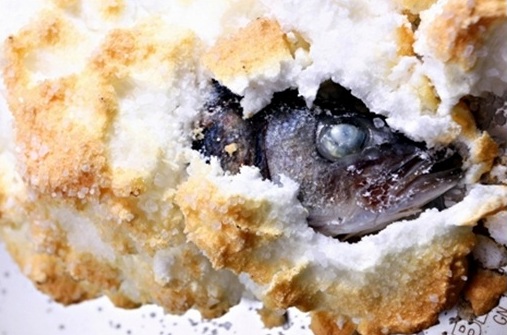My friend and colleague in cyberspace, Chef Miles Collins provided the inspiration for this post by blogging about Salt-Baked Fish – a dish he was prepping for the menu of a family of restaurants in Spain. The restaurants serve up Spanish and related Mediterranean specialties with emphasis on seasonal and locally sourced ingredients. Miles post describes in nice detail how encasing a whole prepared fish in a vault of salt (measured in pounds or kilos) and baking it acts to steam and flavor the fish in a simple but delicious way. Some modern recipes call for adding herbs and spices or lemons to the fish prior to covering it with a thick salt crust while others call for adding lemon zest, lavender or other seasoning to the salt to add flavor. Either way, the fun part comes after the baking when the hardened salt crust is cracked to reveal the moist and delectable fish within.
I have long been fascinated by this dish, because so many nations have claimed it as their own. The Spanish have laid claim to it as have the French, Portuguese and Italians. The Moroccans have a version and the dish appears with East Asian additions such as ginger, star anise and wolfberries on Southern Chinese menus. I can smell a Silk Road Mystery from miles away – so I did a little research.
Even a few hundred years ago, this dish would have been expensive to prepare, because of the huge amount of salt needed to prepare it. Further back, it would have been a feast dish or reserved only for the wealthy and prosperous. The only people who could have originated this recipe on an ordinary budget were people in salt-producing areas. The recipe also seemed a bit to simple to be a European dish – or so I thought.
The earliest reference to anything that resembles Salt-Baked Fish in China is a recipe for Salt-Baked Chicken from Dong Jing in Guangdong during the Qing Dyansty (1644-1911). The recipe actually arose from the earlier preservation of cooked chickens in the salt fields of the area – which gave added flavor. I wasn’t satisfied, however, that this was the root recipe for the Spanish one that Miles blogged about, so I kept on digging.
Thinking about other salt producing areas, I turned next to North Africa or other parts of the Muslim world for the source of the recipe. I found one reference to it in Lilia Zaouali’s Medieval Cuisine of the Islamic World. She writes about Shad Cooked in Salt which she says comes from, “a thirteenth century Muslim cookbook”. Unfortunately, that is the only definitive historical provenance that is offered for the recipe. It might be from Ibn Khalsun, an Andalusian author, but I’m guessing. In that recipe, one puts a layer of salt on a new terra-cotta tile, place the prepped fish on top, add another layer of salt and bake it in an oven – sounds like a good ancestral recipe for the Spanish one being offered at the restaurants that Miles creates menus for. Interestingly, the 13th Century recipe serves the fish with a selection of sauces, including: 1.) an appetizing sauce of oil, garlic, ginger, cinnamon, salt and black or long pepper; and 2.) a dark sauce (called murri) of small fish fermented with salt, oil, aromatic herbs, fennel and coriander. There is a lot of regional variation for murri recipes, but some call for barley, still others for wine.
But, the story doesn’t end in the 13th Century.
The earliest recipe I’ve found to date for salt-baked fish is from the 4th Century BCE in the fragments of Archestratus’ Life of Luxury. Archestratus was a Greek living in Sicily who espoused simple cooking methods, usually with minimal herbs and flavorings added to meats and fish. The only excption to this that I can find is a few strongly flavored sauces to optionally accompany cooked main dishes. His recipe calls for a whole, round white fish such as sea bass, sea bream or snapper that was cleaned and gutted. The fish is seasoned only with a few springs of thyme inserted into the cavity of the fish prior to encasing it in two pounds of salt moistened with water and egg whites. Baked and crust removed, the fish is served simply by drizzling first press olive oil on it.
So the simplicity I thought African or Arab was really that of Ancient Greece. They could have adopted the recipe from other shores or lands, of course, but without earlier documentation, the Greeks seem to be to originators of this recipe now claimed by almost every nation with a Mediterranean beach. Interestingly, this may be a recipe adopted by the sea-faring Chinese from contacts in the Mediterranean. Still, I keep an open mind and ask that if anyone has heard of an earlier use of this sort of cooking, please let me know. (Words by Laura Kelley, Photo of Salt-Baked Fish by Dextrosa | Dreamstime.com)

